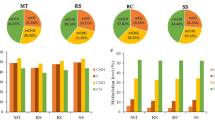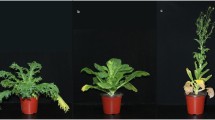Abstract
Background
Lycium ruthenicum is an eco-economic shrub which can exist in two forms, thorny and thornless under varying soil moisture conditions. The aim of this study was to determine if the two forms of L. ruthenicum were influenced by soil water content (SWC) and to test the three-way link among SWC, occurrence of branch-thorn and DNA methylation modification.
Methods and results
Here, pot experiment was carried out to reveal the influence of SWC on the occurrence of branch-thorn and then paraffin sections, scanning electron microscope and methylation-sensitive amplification polymorphism(MSAP) analysis were used to determine the three-way link among SWC, branch-thorn occurrence and DNA methylation. The results showed that (a) soil drought promoted the development of thorn primordium into branch-thorn and (b) branch-thorn covered axillary bud to protect it against drought and other stresses; (c) the branch-thorn occurrence response to drought was correlated with hypermethylation of CCGG sites and (d) thorny and thornless plants of a clone were distinguished successfully based on the MSAP profiles of their leaves.
Conclusions
Branch-thorns of the L. ruthenicum clone, which occurred in response to drought, covered axillary buds to protect them against drought and other stresses; thorn primordium of the clone did not develop into branch-thorn under the adequate soil moisture condition. The occurrence and absence of the branch-thorns were correlated with the hyper- and hypo-methylation, respectively. We proposed that the branch-thorn plasticity might be an adjustment strategy for the environment, which seems to support the theory of "Use in, waste out".




Similar content being viewed by others
Data availability
The datasets used and/or analyzed during the current study are all in the supplementary materials.
Code availability
Not applicable.
References
Sow MD, Le Gac A-L, Placette CL et al (2018) Clarifying the role of DNA methylation in tree phenotypic plasticity. In: 43rd FEBS congress, biochemistry forever, Prague Czech Republic, ffhal-02736952.
Zhang YY, Fischer M, Colot V, Bossdorf O (2012) Epigenetic variation creates potential for evolution of plant phenotypic plasticity. New Phytol 197:314–322
Kou S, Gu Q, Duan L et al (2021) Genome-wide bisulphite sequencing uncovered the contribution of DNA methylation to rice short-term drought memory formation. J Plant Growth Regul. https://doi.org/10.1007/s00344-021-10483-3
Gayacharan JAJ (2013) Epigenetic responses to drought stress in rice (Oryza sativa L.). Physiol Mol Biol Plants 19:379–387
Xia H, Huang W, Xiong J et al (2017) Differentially methylated epiloci generated from numerous genotypes of contrasting tolerances are associated with osmotic-tolerance in rice seedlings. Front Plant Sci. https://doi.org/10.3389/fpls.2017.00011
Deng KW, Li YL, Xiao M et al (2020) Lycium ruthenicum Murr. polysaccharide protects cortical neurons against oxygen-glucose deprivation/reperfusion in neonatal hypoxic-ischemic encephalopathy-sciencedirect. Int J Biol Macromol 158:562–568
Gao H, Yuan X, Wang ZS et al (2020) Profiles and neuroprotective effects of Lycium ruthenicum polyphenols against oxidative stress-induced cytotoxicity in PC12 cells. J Food Biochem 44:e13112
Guo YY, Yu HY, Kong DS et al (2016) Effects of drought stress on growth and chlorophyll fluorescence of Lycium ruthenicum Murr. seedlings. Photosynthetica 54:524–531
Wang H, Li J, Tao W et al (2018) Lycium ruthenicum studies: molecular biology, phytochemistry and pharmacology. Food Chem 240:759–766
Dai G, Qin K, Cao YL et al (2013) Characteristics of floral dynamic and breeding system of Lycium ruthenicum. Guihaia 33:126–132
Gao Y, Wang Q-M, An QX et al (2021) A novel micropropagation of Lycium ruthenicum and epigenetic fidelity assessment of three types of micropropagated plants in vitro and ex vitro. Plos One 16:e0247666
Rapp RA, Wendel JF (2005) Epigenetics and plant evolution. New Phytol 168:81–91
Falahi A, Zarei L, Cheghamirza K (2021) Most drought-induced DNA methylation changes switched to pre-stress state after re-irrigation in barley (Hordeum vulgare L.) cultivars. Cereal Res Commun. https://doi.org/10.1007/s42976-021-00189-3
Mao JF, Nie JL, Wu ZR, Yang XJ, Pei Y (2017) Comparison of morphology and structure of stem and leaf of Lycium ruthenicum Murr. under different soil conditions. Bull Bot Res 37:529–534
Pandey S, Goel R, Bhardwaj A et al (2018) Transcriptome analysis provides insight into prickle development and its link to defense and secondary metabolism in. Sci Rep-UK 8:17092
Wang Q-M, Wang YZ, Sun LL et al (2012) Direct and indirect organogenesis of Clivia miniata and assessment of DNA methylation changes in various regenerated plantlets. Plant Cell Rep 31:1283–1296
Franc-Christophe B, Joris N, Thierry L, Jean-Luc V, Olivier M (2004) Genomic DNA methylation of juvenile and mature Acacia mangium micropropagated in vitro with reference to leaf morphology as a phase change marker. Tree Physiol 24:401–407
López CMR, Wetten AC, Wilkinson MJ (2010) Progressive erosion of genetic and epigenetic variation in callus-derivedcocoa (Theobroma cacao) plants. New Phytol 186:856–868
Wang Q-M, Wang L, Zhou Y et al (2016) Leaf patterning of Clivia miniata var. variegata is associated with differential DNA methylation. Plant Cell Rep 35:167–184
Bonin A, Bellemain E, Eidesen PB, Pompanon F, Taberlet P (2004) How to track and assess genotyping errors in population genetics studies. Mol Ecol 13:3261–3273
Cao YL, Li YL, Fan YF et al (2021) Wolfberry genomes and the evolution of Lycium (Solanaceae). Commun Biol. https://doi.org/10.1038/s42003-021-02152-8
Vilela AE, Aguero PR, Ravetta DA, Gonzalez-Paleo L (2012) Long-term plasticity in growth, storage and defense allocation produces drought-tolerant juvenile shrubs of Prosopis alpataco R.A. Philippi (Fabaceae). Flora Jena 207:436–441
Gowda J, Raffaele E (2004) Spine production is induced by fire: a natural experiment with three Berberiss pecies. Acta Oecol 26:239–245
Gowda JH (1997) Physical and chemical response of juvenile Acacia tortilis trees to browsing: experimental evidence. Funct Ecol 11:106–111
Milewski AV, Young TP, Madden D (1991) Thorns as induced defenses: experimental evidence. Oecologia 86:70–75
Young TP (1987) Increased thorn length in Acacia depranolobium—an induced response to browsing. Oecologia 71:436–438
Miao Q, Zhai Q, Qu B et al (2020) A new understanding of the spines in genus berberis: morphology and occurrence of spines in Berberis thunbergii var. atropurpurea. Bull Bot Res 40:172–176
Zhang F, Rossignol P, Huang TB et al (2020) Reprogramming of stem cell activity to convert thorns into branches. Curr Biol 30:1–11
Herrera CM, Bazaga P (2013) Epigenetic correlates of plant phenotypic plasticity: DNA methylation differs between prickly and nonprickly leaves in heterophyllous Ilexaquifolium (Aquifoliaceae) trees. Bot J Linn Soc 171:441–452
Telias A, Lin-Wang K, Stevenson DE, Cooneyet JM, Bradeen JM (2011) Apple skin patterning is associated with differential expression of MYB10. BMC Plant Biol 11:93
Ong-Abdullah M, Ordway JM, Nan J et al (2015) Loss of Karma transposon methylation underlies the mantled somaclonal variant of oil palm. Nature 525:533–537
Amoah S, Wilkinson M, Dunwell J, King G (2008) Understanding the relationship between DNA methylation and phenotypic plasticity in crop plants. Comp Biochem Phys 150:S145
Bossdorf O, Arcuri D, Richards CL, Pigliucciet M (2010) Experimental alteration of DNA methylation affects the phenotypic plasticity of ecologically relevant traits in Arabidopsis thaliana. Evol Ecol 24:541–553
Cubas P, Vincent C, Coen E (1999) An epigenetic mutation responsible for natural variation in floral symmetry. Nature 401:157–161
Ogran A, Conner J, Agrawal AA, Barazani O (2020) Evolution of phenotypic plasticity: genetic differentiation and additive genetic variation for induced plant defence in wild arugula Eruca sativa. J Evol Biol 33:237–246
Funding
This research was supported by the Opening Project of State Key Laboratory of Tree Genetics and Breeding (K2019202), the National Natural Science Foundation of China (31600546) and the Scientific Research Fund of Liaoning Provincial Education Department (LSNJC202023).
Author information
Authors and Affiliations
Contributions
Conceptualization: Q-MW; Methodology: AY and XQ; Formal analysis and investigation: LL and WL; Writing—original draft preparation: Q-MW, AY, XQ and HW; Writing—review and editing: Q-MW and AY; Funding acquisition: Q-MW; Resources: YQ and WL; Supervision: YW.
Corresponding author
Ethics declarations
Conflict of interest
The authors declare that they have no conflict of interests.
Ethical approval
This article does not contain any studies with animals performed by any of the authors.
Additional information
Publisher's Note
Springer Nature remains neutral with regard to jurisdictional claims in published maps and institutional affiliations.
Supplementary Information
Below is the link to the electronic supplementary material.
Rights and permissions
About this article
Cite this article
Yang, A., Qi, X., Wang, QM. et al. The branch-thorn occurrence of Lycium ruthenicum is associated with leaf DNA hypermethylation in response to soil water content. Mol Biol Rep 49, 1925–1934 (2022). https://doi.org/10.1007/s11033-021-07004-6
Received:
Accepted:
Published:
Issue Date:
DOI: https://doi.org/10.1007/s11033-021-07004-6




